
In this demonstration at the village of Albourne in Wiltshire, I have tackled a fairly tricky subject not only because it was raining on and off whilst I did my sketching and referencing but because the end result needed muted colours and subtle values. I taped grey Canson Mi-Teintes pastel paper to my drawing board. It offers a choice of a rough or smooth side to suit the method, subject and medium. I decided the smooth was more suitable for this subject and chose grey because it would help capture the atmosphere of the day.
Contè Carrè Crayons offer such a flexible medium – fabulous for line making and fine marks as they are fairly hard but beautifully pigmented. Conversely, for a broader stroke, they respond well to firm pressure or using them on their side. The range of colours in the box of 48 I used here is truly an Aladdin’s cave of endless opportunities.
1 I did my initial drawing using a white crayon, putting a very faint centre line horizontally and vertically and matching it to my reference (not visible here). This simple exercise is a pretty foolproof way to ensure your subject is positioned correctly on the paper.
I did my initial drawing using a white crayon, putting a very faint centre line horizontally and vertically and matching it to my reference (not visible here). This simple exercise is a pretty foolproof way to ensure your subject is positioned correctly on the paper.
2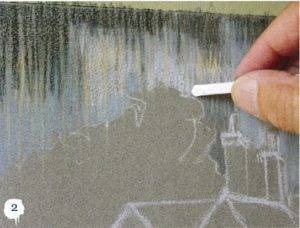 The sky was grey and in places almost black with a few light areas where the occasional shaft of light came through. I used a vertical stroke with one colour and then inter-laid another colour between to ‘optically blend’. I don’t use rubbing at all to blend or smudge because I believe it damages the quality of the pigment and makes the resulting painting muddy. Once I felt happy with the sky for which I used greys, white and a little ochre to lift the lighter areas, I gave the piece a quick spray fix.
The sky was grey and in places almost black with a few light areas where the occasional shaft of light came through. I used a vertical stroke with one colour and then inter-laid another colour between to ‘optically blend’. I don’t use rubbing at all to blend or smudge because I believe it damages the quality of the pigment and makes the resulting painting muddy. Once I felt happy with the sky for which I used greys, white and a little ochre to lift the lighter areas, I gave the piece a quick spray fix.
3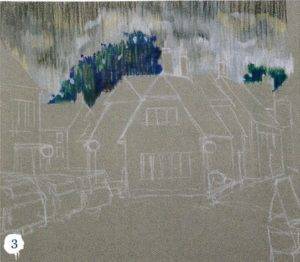 The trees were next. Even though the sky seemed dark it was nowhere near as dark as the trees. I used a purple and a blue with two or three of the darker greens, as before laying one colour alongside another and keeping my strokes vertical encouraging a harmony in the painting. Retaining values across a scene is what will convey mood and atmosphere – hence the saying I often use: ‘the colour gets all the praise but the values do all the work’ – this is never truer than in a dry medium.
The trees were next. Even though the sky seemed dark it was nowhere near as dark as the trees. I used a purple and a blue with two or three of the darker greens, as before laying one colour alongside another and keeping my strokes vertical encouraging a harmony in the painting. Retaining values across a scene is what will convey mood and atmosphere – hence the saying I often use: ‘the colour gets all the praise but the values do all the work’ – this is never truer than in a dry medium.
4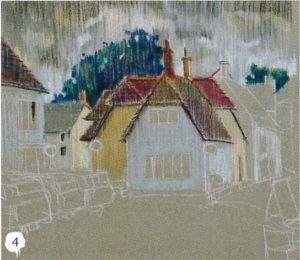 Next for the roof areas. I was concerned that the myriad of subtle values and colours may confuse the viewer if I didn’t approach them with caution. I completed the chimneys being careful to see the perspective and relay the square form of the tall stacks and their changing colours as the light caught them.
Next for the roof areas. I was concerned that the myriad of subtle values and colours may confuse the viewer if I didn’t approach them with caution. I completed the chimneys being careful to see the perspective and relay the square form of the tall stacks and their changing colours as the light caught them.
5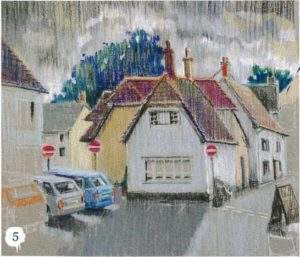 The cars on the left were lit mainly from the top as the buildings cast a subdued shadow, but their shape and colour offer a welcome respite from the straight lines of the buildings and bring to life the painting. The lack of folk was due to the intermittent rain. I was glad that under my umbrella it was at least dry even though a little gloomy. The cottages were mostly painted white, the values therefore subtle. I was grateful for the Ochre on the left off-centre walls as it broke up the overall shades of grey. For the main building facing me, I used a light grey.
The cars on the left were lit mainly from the top as the buildings cast a subdued shadow, but their shape and colour offer a welcome respite from the straight lines of the buildings and bring to life the painting. The lack of folk was due to the intermittent rain. I was glad that under my umbrella it was at least dry even though a little gloomy. The cottages were mostly painted white, the values therefore subtle. I was grateful for the Ochre on the left off-centre walls as it broke up the overall shades of grey. For the main building facing me, I used a light grey.
6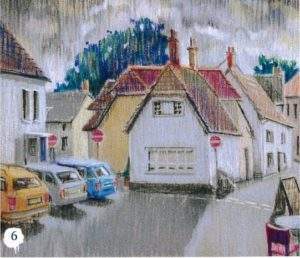 I finished with the table and ‘A’ board of the cafe on the right, providing a dark value and sense of depth, giving the scene a foreground, middle and distant layer which the eye almost expects in a landscape. By the time I’d finished and spray fixed for about five seconds all over the piece I was confident I had Aldbourne Village captured in Contè.
I finished with the table and ‘A’ board of the cafe on the right, providing a dark value and sense of depth, giving the scene a foreground, middle and distant layer which the eye almost expects in a landscape. By the time I’d finished and spray fixed for about five seconds all over the piece I was confident I had Aldbourne Village captured in Contè.